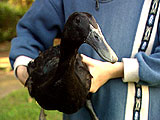Breed: Indian Runner Duck
Temperament: excitable, timid but can be tamed
Cost: From around $6 for a pet to $50 for show quality
Lifespan: 8 – 10 years
Recommended for: fenced gardens
Maintenance: low
Appearance
Unlike other ducks, the Indian Runner does not waddle but rather the position of its legs gives them a characteristic running motion.Another peculiarity of the Indian Runner Duck is its shape which is described as being like a wine bottle. They also have long, snake-like necks. When wandering around they walk flat but stand upright when disturbed. Exhibitors often train their ducks to stand upright but their methods are usually kept secret. Indian Runners are a relatively small breed of duck, with the standard listing 1.6-2.25kg (3.5-5lb) for drakes and 1.35-2 kg (3-4.5lb) for ducks. Drakes are 65-80cm (26-32 in.), ducks 60-70 cm (24-28 in.).
Temperament
Indian Runner Ducks can be easily handled by people, especially if they are exhibited. Apart from excitability when disturbed (ie if an outside light is switched on after they have settled themselves for the night), Indian Runner Ducks don’t have any unusual personality traits. They can be prone to panic if cornered.
History
The Indian Runner Duck breed is believed to have originated in South East Asia, probably the islands of Indonesia, an area once known as the Dutch East Indies, hence the name Indian Runner. Texts refer to a ship’s captain who took fawn and fawn and white-coloured ducks from Malaya back to his home in Dumfries, Scotland, where the ducks were distributed across the border into Cumberland. It is understood that fawns were first exhibited in 1876, while fawn and whites were shown in 1896. The Indian Runner Duck Club standard for fawn and whites was accepted in 1913. They are not a common breed in Australia.
Health and lifespan
Worms are the most common health problem with these ducks. It is recommended that any new ducks be wormed immediately, then 21 days later and again 21 days after that, then every 5-6 months. Ducks may also need to be dusted for parasites on the head area.
Feeding
Duck pellets are readily available. A 40 kg bag of duck pellets should last an adult pair at least one month. Duck feed should be placed in bowls to prevent contamination. Water bowls should be accessible at all times and should be anchored with bricks to prevent the ducks turning them over.
Breeding
Although Indian Runners are prolific egg-layers, they are not very broody. Therefore, if you wish to breed them, and you don’t have access to an incubator (which many breeders use), the eggs should be placed under another broody duck to hatch. Indian Runners, unlike some other duck breeds, do not need water for breeding (although they must have water available at all times for drinking). Ducklings are best raised in small flocks.
Cost
Pet Indian Runner Ducks may be obtained for as little as $5 to $6 from breeders who wish to reduce their stocks. Show quality ducks cost around $50.
Housepet Potential
Indian Runners could not be described as ‘pets’ as they are not capable of interaction with humans on any scale beyond responding to food. They are unable to live indoors but as a garden duck, they can be useful for providing fertiliser and for keeping spiders, snails and slugs away.
Space and exercise
Indian Runner Ducks can be successfully kept in a penned are or allowed to roam free within a fenced boundary. They require access to water in which to bathe – the water must be a depth which allows to ducks to submerge themselves such as a pond or dam.
Ideal Owner
Breeders say these ducks can be successfully kept by poultry enthusiasts of all ages and ability. They are best suited to people who have a yard area available and can offer the ducks a penned or caged area for protection at night.
Uses
Indian Runners produce large quantities of eggs. The ducks themselves have enough flesh on them to feed two people and their meat is less fatty than other duck breeds.
Further Information
Our story was filmed with the assistance of the Exhibition Poultry Association of NSW
Secretary – Dr David Cupitt
PO Box 1048
Windsor NSW 2756
Phone: (02) 4577 6830
The auctions mentioned in the segment operate each Saturday selling general goods, livestock, produce, aviary birds and poultry. They are held at
McGraths Hill Auctions
Lot 3 Mulgrave Road
McGraths Hill, NSW, (One hour from Sydney via Windsor Road).
Poultry – Jeff Mack, McGraths Hill Poultry and Produce Auction (at poultry shed).
Selling: produce from 9.30am; aviary birds from 10.30am; and large poultry from 1pm each Saturday.
General auction – John Murray Auctions.
Selling: bric-a-brac, farm
equipment, furniture and general goods.
Time: from 9am each Saturday.
Phone: (02) 4587 8525. Livestock – Phone: (02) 4577 6153
People located outside Sydney should contact the Royal Agricultural Society in your state for the name, address and telephone number of the waterfowl club nearest to you.
A useful internet site to locate breeders of waterfowl is the Australian Online Breeders Directory
http://insight.iinet.net.au/breeders/



